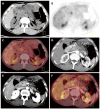Cross-modality PET/CT and contrast-enhanced CT imaging for pancreatic cancer
- PMID: 25780297
- PMCID: PMC4356919
- DOI: 10.3748/wjg.v21.i10.2988
Cross-modality PET/CT and contrast-enhanced CT imaging for pancreatic cancer
Abstract
Aim: To explore the diagnostic value of the cross-modality fusion images provided by positron emission tomography/computed tomography (PET/CT) and contrast-enhanced CT (CECT) for pancreatic cancer (PC).
Methods: Data from 70 patients with pancreatic lesions who underwent CECT and PET/CT examinations at our hospital from August 2010 to October 2012 were analyzed. PET/CECT for the cross-modality image fusion was obtained using TureD software. The diagnostic efficiencies of PET/CT, CECT and PET/CECT were calculated and compared with each other using a χ(2) test. P < 0.05 was considered to indicate statistical significance.
Results: Of the total 70 patients, 50 had PC and 20 had benign lesions. The differences in the sensitivity, negative predictive value (NPV), and accuracy between CECT and PET/CECT in detecting PC were statistically significant (P < 0.05 for each). In 15 of the 31 patients with PC who underwent a surgical operation, peripancreatic vessel invasion was verified. The differences in the sensitivity, positive predictive value, NPV, and accuracy of CECT vs PET/CT and PET/CECT vs PET/CT in diagnosing peripancreatic vessel invasion were statistically significant (P < 0.05 for each). In 19 of the 31 patients with PC who underwent a surgical operation, regional lymph node metastasis was verified by postsurgical histology. There was no statistically significant difference among the three methods in detecting regional lymph node metastasis (P > 0.05 for each). In 17 of the 50 patients with PC confirmed by histology or clinical follow-up, distant metastasis was confirmed. The differences in the sensitivity and NPV between CECT and PET/CECT in detecting distant metastasis were statistically significant (P < 0.05 for each).
Conclusion: Cross-modality image fusion of PET/CT and CECT is a convenient and effective method that can be used to diagnose and stage PC, compensating for the defects of PET/CT and CECT when they are conducted individually.
Keywords: Contrast enhancement; Diagnostic imaging; Pancreatic neoplasms; Positron-emission tomography; Staging; Tomography, X-ray computed.
Figures



Similar articles
-
The value of PET/CT for preoperative staging of advanced gastric cancer: comparison with contrast-enhanced CT.Eur J Radiol. 2011 Aug;79(2):183-8. doi: 10.1016/j.ejrad.2010.02.005. Epub 2010 Mar 11. Eur J Radiol. 2011. PMID: 20226612
-
Staging accuracy of pancreatic cancer: comparison between non-contrast-enhanced and contrast-enhanced PET/CT.Eur J Radiol. 2014 Oct;83(10):1734-9. doi: 10.1016/j.ejrad.2014.04.026. Epub 2014 Jul 1. Eur J Radiol. 2014. PMID: 25043494
-
Comparison of (11)C-choline PET/CT and enhanced CT in the evaluation of patients with pulmonary abnormalities and locoregional lymph node involvement in lung cancer.Clin Lung Cancer. 2012 Jul;13(4):312-20. doi: 10.1016/j.cllc.2011.09.005. Epub 2011 Dec 17. Clin Lung Cancer. 2012. PMID: 22182444 Clinical Trial.
-
Positron emission tomography modalities prevent futile radical resection of pancreatic cancer: A meta-analysis.Int J Surg. 2017 Oct;46:119-125. doi: 10.1016/j.ijsu.2017.09.003. Epub 2017 Sep 7. Int J Surg. 2017. PMID: 28890410 Review.
-
The Role of Positron Emission Tomography/Computed Tomography in Management and Prediction of Survival in Pancreatic Cancer.J Comput Assist Tomogr. 2016 Jan-Feb;40(1):142-51. doi: 10.1097/RCT.0000000000000323. J Comput Assist Tomogr. 2016. PMID: 26484961 Review.
Cited by
-
A Panel of CA19-9, Ca125, and Ca15-3 as the Enhanced Test for the Differential Diagnosis of the Pancreatic Lesion.Dis Markers. 2017;2017:8629712. doi: 10.1155/2017/8629712. Epub 2017 Mar 5. Dis Markers. 2017. PMID: 28356610 Free PMC article.
-
The Role of Positron Emission Tomography/Computed Tomography (PET/CT) for Staging and Disease Response Assessment in Localized and Locally Advanced Pancreatic Cancer.Cancers (Basel). 2021 Aug 18;13(16):4155. doi: 10.3390/cancers13164155. Cancers (Basel). 2021. PMID: 34439307 Free PMC article. Review.
-
Diagnostic accuracy of different imaging modalities following computed tomography (CT) scanning for assessing the resectability with curative intent in pancreatic and periampullary cancer.Cochrane Database Syst Rev. 2016 Sep 15;9(9):CD011515. doi: 10.1002/14651858.CD011515.pub2. Cochrane Database Syst Rev. 2016. PMID: 27631326 Free PMC article. Review.
-
A radiomics model that predicts lymph node status in pancreatic cancer to guide clinical decision making: A retrospective study.J Cancer. 2021 Aug 22;12(20):6050-6057. doi: 10.7150/jca.61101. eCollection 2021. J Cancer. 2021. PMID: 34539878 Free PMC article.
-
Imaging modalities for characterising focal pancreatic lesions.Cochrane Database Syst Rev. 2017 Apr 17;4(4):CD010213. doi: 10.1002/14651858.CD010213.pub2. Cochrane Database Syst Rev. 2017. PMID: 28415140 Free PMC article. Review.
References
-
- Jemal A, Siegel R, Ward E, Hao Y, Xu J, Murray T, Thun MJ. Cancer statistics, 2008. CA Cancer J Clin. 2008;58:71–96. - PubMed
-
- Li D, Xie K, Wolff R, Abbruzzese JL. Pancreatic cancer. Lancet. 2004;363:1049–1057. - PubMed
-
- Kim MJ, Lee KH, Lee KT, Lee JK, Ku BH, Oh CR, Heo JS, Choi SH, Choi DW. The value of positron emission tomography/computed tomography for evaluating metastatic disease in patients with pancreatic cancer. Pancreas. 2012;41:897–903. - PubMed
-
- Saito M, Ishihara T, Tada M, Tsuyuguchi T, Mikata R, Sakai Y, Tawada K, Sugiyama H, Kurosawa J, Otsuka M, et al. Use of F-18 fluorodeoxyglucose positron emission tomography with dual-phase imaging to identify intraductal papillary mucinous neoplasm. Clin Gastroenterol Hepatol. 2013;11:181–186. - PubMed
-
- Lee JW, Kang CM, Choi HJ, Lee WJ, Song SY, Lee JH, Lee JD. Prognostic Value of Metabolic Tumor Volume and Total Lesion Glycolysis on Preoperative 18F-FDG PET/CT in Patients with Pancreatic Cancer. J Nucl Med. 2014;55:898–904. - PubMed
Publication types
MeSH terms
Substances
LinkOut - more resources
Full Text Sources
Other Literature Sources
Medical

